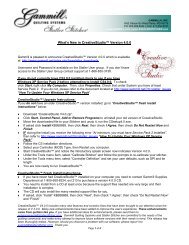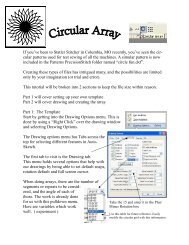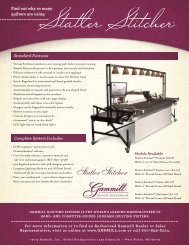You also want an ePaper? Increase the reach of your titles
YUMPU automatically turns print PDFs into web optimized ePapers that Google loves.
128<br />
Getting Started with CreativeStudio<br />
Tip: It is a good idea to preview how the corners and border<br />
patterns will fit together before stitching anything.<br />
* Start with the Border/Corner feature, using the actual quilt<br />
measurements. Place the corner patterns but don't stitch them yet.<br />
* Continue with the Repeat Pattern feature also using the actual<br />
quilt measurements. Place the border patterns and check the size<br />
and alignment, but don't stitch them yet.<br />
* Draw a sketch and make notes of the measurements.<br />
* Extend the sketch to include the side border placement. Be sure the<br />
border pattern fits the side borders as well as the top/bottom<br />
borders.<br />
* SAVE the project !<br />
Turning the Quilt<br />
When it is really important to get the perfect heirloom fit, turning the quilt to do the<br />
side borders makes sense. The four corners and top borders are done when the<br />
body of the quilt top is being quilted. Be sure to baste the side edges of the borders<br />
as you roll the quilt. Securing the border seams with SID is often a good idea too<br />
because it helps prevent the layers from shifting.<br />
When ready to remove the quilt, find the halfway point of the side borders, and mark<br />
it on both sides with a safety pin. This point will be aligned to the center point of the<br />
table leaders when it is reloaded. Carefully remove the quilt from the table leaders.<br />
Rotate the quilt and re-load, attaching just the backing to the leaders. The side<br />
borders have been moved to the top and bottom edges and can now be measured<br />
and stitched as a unit.<br />
Tip: Dense background fillers should be stitched last, after the<br />
borders have been completed. Any dense quilting in the background<br />
around custom quilt designs can make the fabric shrink. When this<br />
happens next to a border it can cause the border fabric to pucker<br />
and tucks are likely. A better method is to wait until all the blocks<br />
and borders have been completed and do the background fillers last.<br />
Quick Reference Border-Corner<br />
176<br />
4.3.7 Sashings using Point_To_Point - Pattern<br />
Sashings are mini-borders with an additional design requirement; they need to<br />
intersect each other and still look attractive. Placing border patterns (using Repeat<br />
Pattern feature) in sashing areas is possible but each sashing strip needs to be<br />
measured and squared up individually. The Point To Point technique using the right





